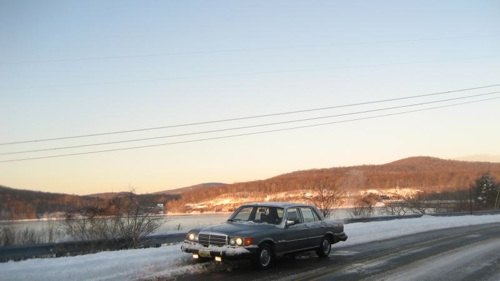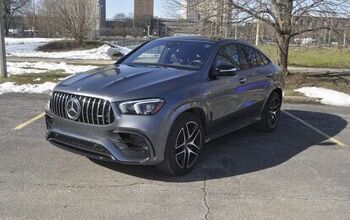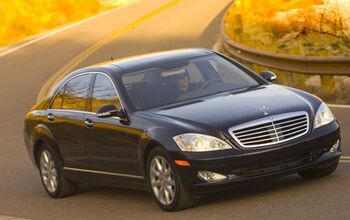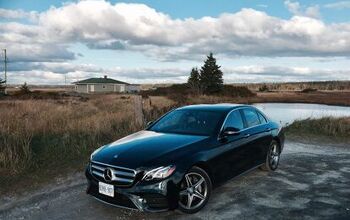Review: 1975 Mercedes-Benz 280S
They don’t build them like they used to. Really. I have yet to come across an car as solid as an old Mercedes, say pre-1998, before the Chrysler-DaimlerBenz AG “merger of equals.” If I had to choose one car to represent the pinnacle of—and benchmark for—Mercedes’ build quality, it would be the W116 S-Class. Hence my decision to restore a barn-found 1975 280S.
The W116 was the first Mercedes luxury sedan to be called the S-Class (the Sonderklasse or “special class”). From a design point-of-view, the 280S is old school, heavily inspired by the R107 450SL roadster and coupe that debuted several years earlier. Unlike the pretentious Rolls-Royce and Bentleys of its day, Mercedes’ three-box had both überholprestige and understated elegance. It’s sleek, refined and tasteful, with a broad shoulder line that gives it a masculine demeanor. At the same time, the big Benz’s wedge shape keeps the gargantuan sedan (17′ long) from looking overwhelmingly large.
Pulling the 280S’s protruding chrome door handle yields a suitably loud metallic clank. Nestling into in the S car’s therapeutic bucket seats, it’s easy to imagine the 280S as intercontinental transportation. Although the project car’s interior is a little warped from a year outdoors—not to mention the fact that it’s 34 years old—the cabin’s held up well. All materials and surfaces are soft to the touch, with brand-appropriate stolidity. Stoic, Teutonic, and dark. Check, check, check.
The 280S’s monstrous dash stretches across the entire width of the car; and there’s not much going on save a strip of wood lining the center. The climate and radio ergonomics are less than spectacular. While the switchgear maintains its tactile and firm feel, the main controls are virtually indistinguishable from one another.
In today’s day and age, the Mercedes Benz 280S seems woefully underpowered. Its carbureted 2.8-Liter DOHC straight six is rated at 160hp and 167 lb·ft of torque, peaking at 5,500 and 4,000 RPM respectively. Channeled through a short-ratio, four-speed automatic, the 280S’s acceleration is nothing more than adequate around town. Steep inclines and highway driving demand lots of wide open throttle and downshifting—just to keep up with traffic. No surprise: the M110 engine has to motivate about 3800 lbs worth of German steel.
The 280S [barely] achieved 12 mpg city/17 mpg highway. Back in the days of the fuel crisis and the newfangled lead-free fuel, these numbers and performance figures were . . . tolerable. The performance, not so much. Zero to sixty clocks in at about 11 seconds. The top speed lives in the vicinity of 120MPH. Again, that’s not bad for 1975. More importantly, the M110 engine’s smoothness rivals many modern straight sixes. Power delivery is wonderfully progressive. And, boy, does the 280S like to rev.
Handling is the 280S’s strong suit. The sedan tapped into technology from the famed C111 development test car. The 280S sports a double wishbone suspension with a torsion bar stabilizer up front, delivering zero offset and camber. The engineers added progressive anti-dive geometry to keep that big body stable under hard braking. They modified the once camber-change susceptible diagonal rear swing axle—the one that made the Chevrolet Corvair such a dangerous car to drive—with control arms that keep the camber change at bay (again, zero offset and camber).
The result: Mercedes’ traditional firm yet compliant ride quality. The Mercedes-Benz 280S will absorb potholes, dips, dives, imperfections without a care. Absolutely nothing can upset this car’s chassis. It has such a surefooted stance that it seems unstoppable.
Take the 280S on a long sweeping road, control the transmission via the shift gate, and it will negotiate a corner with swan-like grace. With its near-50/50 weight distribution, well thought out suspension tuning and a stiff chassis, the 280S is as neutral as Switzerland.
Mercedes designed the 280S’s handling limits to exceed the average driver’s skills, making the sedan easy and safe to drive—with plenty of potential for tire-squealing hoonery. The car’s wide track keeps lateral body motions well controlled. Its recirculating ball steering provides enough feel and feedback to tell you when the front wheels start to lose grip. And while the 280S doesn’t hide its massive size and bulk, it’s as easy to maneuver as a present day Honda Accord. At 2.7 turns lock-to-lock with a large diameter steering wheel, parallel parking the big Benz is a breeze.
Unlike BMWs of its day, the 280S is a perfect example of Mercedes-Benz’ ideology of blending safety, performance and comfort. The 280S is such a docile machine that it’s hard to imagine how far ahead of its time this car was, let alone its more expensive siblings (the 450SEL and the legendary 450SEL 6.9). If today’s Mercedes had continued to construct cars like the W116, rather than reaching downmarket, Mercedes would have maintained their reputation and a legitimate claim on producing the world’s best engineered cars.
[ Click here for more of Chris Chin’s at finaldrivepublications.blogspot.com]
More by Chris Chin
Latest Car Reviews
Read moreLatest Product Reviews
Read moreRecent Comments
- Thomas Same here....but keep in mind that EVs are already much more efficient than ICE vehicles. They need to catch up in all the other areas you mentioned.
- Analoggrotto It's great to see TTAC kicking up the best for their #1 corporate sponsor. Keep up the good work guys.
- John66ny Title about self driving cars, linked podcast about headlight restoration. Some relationship?
- Jeff JMII--If I did not get my Maverick my next choice was a Santa Cruz. They are different but then they are both compact pickups the only real compact pickups on the market. I am glad to hear that the Santa Cruz will have knobs and buttons on it for 2025 it would be good if they offered a hybrid as well. When I looked at both trucks it was less about brand loyalty and more about price, size, and features. I have owned 2 gm made trucks in the past and liked both but gm does not make a true compact truck and neither does Ram, Toyota, or Nissan. The Maverick was the only Ford product that I wanted. If I wanted a larger truck I would have kept either my 99 S-10 extended cab with a 2.2 I-4 5 speed or my 08 Isuzu I-370 4 x 4 with the 3.7 I-5, tow package, heated leather seats, and other niceties and it road like a luxury vehicle. I believe the demand is there for other manufacturers to make compact pickups. The proposed hybrid Toyota Stout would be a great truck. Subaru has experience making small trucks and they could make a very competitive compact truck and Subaru has a great all wheel drive system. Chevy has a great compact pickup offered in South America called the Montana which gm could make in North America and offered in the US and Canada. Ram has a great little compact truck offered in South America as well. Compact trucks are a great vehicle for those who want an open bed for hauling but what a smaller more affordable efficient practical vehicle.
- Groza George I don’t care about GM’s anything. They have not had anything of interest or of reasonable quality in a generation and now solely stay on business to provide UAW retirement while they slowly move production to Mexico.





































Comments
Join the conversation
Chris, I recently purchased a 1975 280 S... after reading your blog, I am convinced that my $900 75% fully restored gem is worth it. I don;t know much about restoring cars. Can you point me out to the right direction? Catalogs? Blogs? Etc... thanks!
Cool to see this W116. As a W126 owner (91' 420 SEL) I couldn't agree more about quailty. My W126 is a tank...a very luxurious tank too. The quality is first rate. I considered moving up to a W140, but so many things looked cheap on it. So I decided to stay with a good thing. The cost cutting on newer S-class models is sad. Although I think the current S-Class is headed in the right direction. Love to see a review on W126 models if possible.